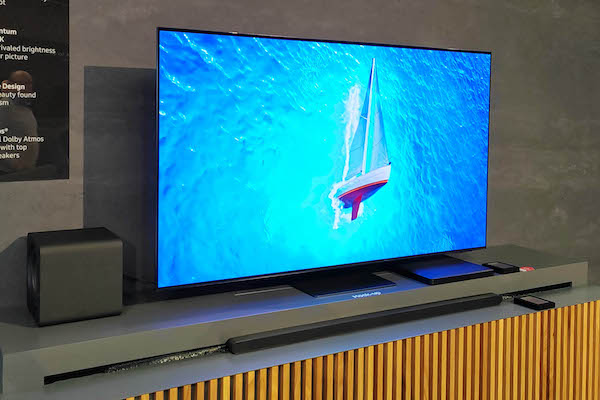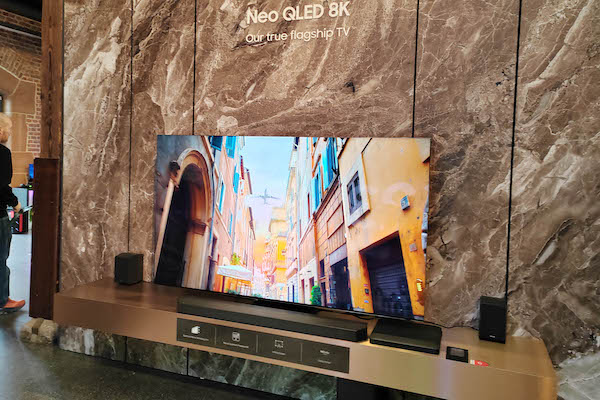Hands-on: Samsung previews 2023 QD OLED, Neo QLED Mini LED and 4K QLED TVs

HCC was there for the big TV reveal and we’ve taken a close look at all the major models from the brand – and certain to attract huge attention from cinephiles are the two new Quantum Dot OLED screens, the S90C and flagship S95C.
The S95C is easily distinguished from its stablemate due to a newly redesigned One Connect Box. This external tuner and interface hardware can lock onto the back of the panel, if you don’t want to put it in your equipment rack.
The TV gets has a so-called LaserSlim design yet still manages to pack in a 70W-rated multichannel OTS+ sound system. It also debuts a new screen filter said to reduce the chance of image burn – good news for gamers.
Both the S95C and the S90C will be available in 55in, 65in and 77in screen sizes. The S90C model is slightly more conventional, with all inputs and tuner built in.

The big question is what’s the difference between the two QD OLED models when it comes to image quality? We can confirm the S95C benefits from a big brightness boost over last year’s Samsung QD OLED debut, with a claimed peak HDR brightness of some 2000 nits. This has been achieved through the development of new panel technology and algorithms.
When asked if the S90C uses the same panel as the S95C, Samsung is predictably coy. While it confirms the S90C isn’t as bright as its brother when it comes to peak brightness, it declines to go into specifics. Samsung suggests that the S90C has a peak HDR brightness of 1,000 nits, which is comparable to 2022’s S95B model.
We pushed them on this discrepancy and received the following statement: ‘The S95C and 90C performances are different (line-up differentiation), unfortunately, we do not disclose detailed panel information.’ Make of that what you will…
The S95C certainly looked spectacular at its Frankfurt unveiling. This brightness boost clearly leads to greater colour depth and vibrancy. Are we seeing a new benchmark being set for OLED picture quality? We can’t wait to get one in for review.

Samsung is also doubling down on 8K for 2023, having finally worked out how to live within the EU’s restrictive power consumption mandates (its solution is to ship new 8K screens with a low-brightness Eco mode as the default setting, but the good news is that you can manually deselect this dim option and enjoy the panel’s image quality unfettered).
There will be three 8K TV models in the 2023 lineup: the QN900C, QN800C and the QN700C. All use One Connect boxes. The QN900C and QN800C will be available in 65in, 75in and 85in, while the QN700C is available at 55in, 65in and 75ins. You get fewer dimming zones as you step down the range.
Finally, when it comes to 4K QLED, expect to see Q60C, Q70C, and Q80C ranges, alongside the Neo QLED with Mini LED QN85C, QN90C and QN95C.
We were really impressed with the QN95C, which benefits from more dimming zones and looks far less prone to blooming artefacts than previous Mini LED designs. There are no One Connect Boxes with these screens, but they all boast a slick 'Infinity One' design.
Naturally, audio systems vary between models, but the higher-end options all include immersive OTS sound systems. They also come with 4K/120Hz HDMI support as standard, as well as a host of VRR and gaming options.
 |
Home Cinema Choice #351 is on sale now, featuring: Samsung S95D flagship OLED TV; Ascendo loudspeakers; Pioneer VSA-LX805 AV receiver; UST projector roundup; 2024’s summer movies; Conan 4K; and more
|








































